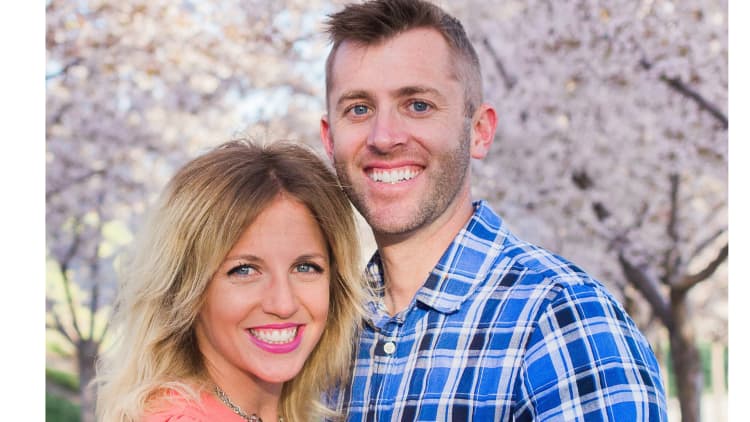Jaime Masters seemed to be living the American dream. By 24, she had a college degree and a six-figure salary, owned two homes with her husband and two dogs, and bought a brand-new car to prepare to start a family.
Sounds ideal, right? Well, along with that fantasy life came a ton of debt.
Masters totaled up the debt one day — $19,300 for a car, $26,180 in student loans, and $24,560 in a home equity loan — and found she was just over $70,000 in the hole. On top of that, she hated her career, but she was the breadwinner of the family.
"The breaking point for tackling this debt was when I realized I wanted to quit my job and start a family," says Masters. "As soon as I got pregnant, it really amped up the payoff momentum."
More from Student Loan Hero:
7 bigger ways to save money instead of pinching pennies
How one entrepreneur built a successful business using a personal loan and credit cards
10 remote companies offering unique perks for your next dream job
So she got serious about paying off the debt. And 16 months later, Masters was debt-free and living her real dream life. She became a business coach, host of the "Eventual Millionaire" podcast, and author of the best-selling book, "Eventual Millionaire: How Anyone Can Be an Entrepreneur and Successfully Grow Their Startup."
Masters now spends her days commanding top dollar for her advice and interviewing millionaires. She recently launched her new entrepreneur group-training brand OwnerBox. Sounds good, right?
4 tips for paying off debt and becoming a successful entrepreneur
Here's how the popular business coach tackled her student loans and other debt quickly while building a business — and how you can do the same.
1. Adopt a debt payoff method
Like many other people who face a mountain of debt, Masters didn't know where to start. So, she began reading books by financial experts. "I used Dave Ramsey's system to pay off my debt," she says.
From his book "The Total Money Makeover," Masters realized she needed to sell her car as the first step in following the famous debt snowball method popularized by Ramsey. She traded in her two-month-old Honda Civic for a 2000 Jeep Cherokee and sold their other Jeep. That brought her total debt down to $55,440 and freed up money to start paying back student loans.
From there, Masters followed the remaining steps in the debt snowball method. Using that strategy, you pay off the smallest loans first while continuing to make minimum payments on the others. Once that loan is paid off, use that monthly payment money toward paying off the next one until everything is paid off.
You also can try the debt avalanche method, which focuses on paying off loans with the highest interest first. Do what works best for you and your situation to get your debt under control.

2. Create a budget
Masters didn't realize how much money she was spending frivolously until she became serious about paying off her debt. All her eating out was wreaking havoc on her bottom line.
So, Masters and her husband cut out their cable bill, lowered their cellphone plan, stopped going out to eat, and created a budget that included only their essential bills and $50 of spending money. "It wasn't easy at first because I was consumed with numbers and it felt like a total lifestyle change," she says. "But it got easier."
To create an easy budget, first examine your credit cards and bank accounts to see where you're spending money. Note what's expendable and what's essential, such as rent, food, and utilities. Then determine which costs you can cut back. Can you lower your cellphone bill? Can you live in a cheaper home? Can you avoid eating out and cook at home instead?
These are all small changes, but they'll free up extra money to help you pay down your debt.
3. Take on a side hustle
Along with cutting their expenses and creating a budget, the duo focused on earning as much money as possible before their baby arrived. "We just worked extra [hard] and had lots of yard sales to make more money to put toward our debt," says Masters.
That meant traveling more for work knowing she could make an extra $40 a day if she worked onsite. Meanwhile, Master's husband took on a variety of side hustles, such as website design. They also held three yard sales one summer, listed unused items for sale on Craigslist, and sold random clothes on eBay. They were able to find side jobs that utilized their skills.
You, too, can partake in the booming sharing economy, doing gigs that don't require a special background. You can deliver food for DoorDash, do handy work with TaskRabbit, or become an Uber driver.
With Uber, for example, you could make an average of $19.04 an hour. That means if you work even one hour a day, you could make almost $7,000 in a year.

4. Have a savings fund
Just before her son was born, Masters had one student loan left to pay off. But she was hesitant to do finish the payoff because of the impending costs associated with having a baby. That was when she first interviewed a successful entrepreneur.
"I got a hold of Dave Ramsey and asked him what to do," says Masters. "He suggested not to pay off the last loan, and keep the money in savings until the medical bills were paid. Then we could pay off the loan."
When her son was born, Masters had a lot of money in the bank, or $23,000 to be exact. It was this safety fund, or as they called it "the baby fund," that helped her finally quit her job and launch her business.
She was able to use the money to stay home with her some for a few months and then figured out that if she went back to work for just two and a half months, she'd be able to pay off the student loan and still have money left over to pay expenses for a year.
By the time her son was 4 months old, Masters was debt-free and job-free, and able to focus on building her website. "I started a website about my money journey and goal to become a millionaire," she says. "But I didn't like writing, so I decided to start interviewing."
The chat with Ramsey inspired her to interview other financial experts. A friend suggested that since her site was called Eventual Millionaire, she could start interviewing millionaires. That effort bred a booming business complete with a podcast, book, and coaching clients. And it was thanks to that savings fund.
Getting out of debt fast takes accountability
Getting out of debt can seem overwhelming, especially if you also want to quit your job or pursue something new. But following these few steps can simplify the process.
The hardest part, according to Masters, is holding yourself accountable. "Accountability is huge," she says. "My husband and I were accountability buddies and would support each other when it would get tough. We also told people about our debt plan, which helped keep us on track."
Not only should you follow specific measures to cut costs and make more money, but also ensure you have a system in place that keeps you on track to meet your debt payoff goal. That combination can help you live the life of your dreams.
Like this story? Subscribe to CNBC Make It on YouTube!
Don't miss: This grad student paid off $60,000 in student loans in 3 years (while making only $30,000)


